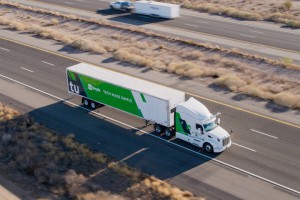Leading the charge on self-driving trucks is TuSimple, a company with dual headquarters in Beijing, China, and in San Diego, California, plus a testing facility in Tucson, Arizona. TuSimple has identified port terminal tractors as an ideal first application for autonomous vehicles.
Port operations are perfect for autonomous vehicles for a number of reasons, but primarily because of the closed and controlled environment in the terminal grounds. Cargo ships are loaded and unloaded and the containers are stacked in neat blocks and closely tracked. Terminal facilities are closed to the public due to safety and customs issues. Roadways are wide and the full map of a port storage yard is comparatively simple. To top it all off, speeds inside the facility are kept low, which creates a perfect scenario for autonomous vehicles.
“This is a great place for autonomous trucks,” explained Chuck Price, Vice President of Product at TuSimple. “With a fully autonomous vehicle, it allows us to introduce our technology into the environment without any infrastructure change in the port. It’s a very quick introduction. They’re very excited about it, and we’re excited to be able to be a part of it.”
 TuSimple has been operating a test fleet of autonomous port terminal tractors in China, and it’s gaining attention there.
TuSimple has been operating a test fleet of autonomous port terminal tractors in China, and it’s gaining attention there.
TuSimple is not only unique in its choice of first applications. The company’s implementation of autonomous driving is also different from other approaches. Instead of relying on laser-based radar (LIDAR), the TuSimple technology is primarily based on cameras.
“The most visible difference between how we’re approaching the problem and how our competition approaches the problem is when we decided to build technology that is camera-centric as opposed to LIDAR-centric,” Price explained. “We use an array of 10 cameras currently, but that number is in flux as we complete our solution. We use radar as a secondary sensor. For the most part, our array of cameras delivers a superior solution to pretty much any other sensors.”
TuSimple also uses millimeter wave radar, but it maintains an array of cameras provides superior results.
The market for autonomous trucks in closed private facilities is large, but nowhere near as large as the market for self-driving trucks on the world’s highways. Like most autonomous developers, TuSimple has been testing its technology in Arizona, which has welcomed the process.
Source: www.digitaltrends.com
You can read the original article here.
Photos: tusimple

